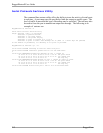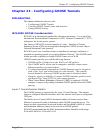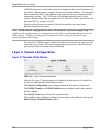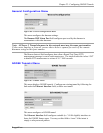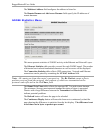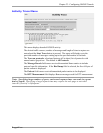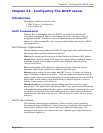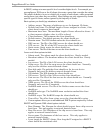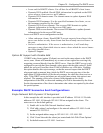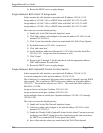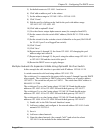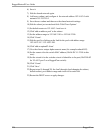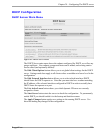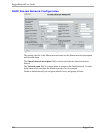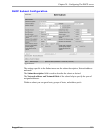
RuggedRouter® User Guide
In DHCP, settings at a more specific level overrides higher levels. For example you
can configure a DNS server for all clients, the create a group that overrides the setting.
This allows defaults to be set at a high level to apply to most clients, while exceptions
can be places just where they are needed. Many settings are only supported by certain
specific types of clients, and are ignored by the majority of clients.
Basic options you should pay attention to include:
• Address ranges: The range of addresses to use for dynamic IP clients.
• Default lease time: The default length of leases assigned to clients, if the
client doesn't request a lease length.
• Maximum lease time: The maximum length of leases allowed to clients. If
a client requests a higher value it will be refused.
• Client hostname: The hostname the client should use.
• Default routers: The default gateway the client should use.
• Domain name: The DNS domain name the client should use.
• DNS servers: The IPs of the DNS servers the client should use.
• NTP servers: The IPs of the NTP servers the client should use.
• Static routes: Static routes the client should use.
• Time servers: The IPs of the time servers the client should use.
Lesser used client options include:
• Subnet mask: The subnet mask the client should use. Rarely needed.
• Broadcast address: The broadcast address the client should use. Rarely
needed.
• Log servers: The IPs of the LOG servers the client should use.
• Swap server: The IP of the swap server the client should use. Normally
only used for diskless network booted clients.
• Root disk path: The path the client should use for its root device.
Normally only used for diskless network booted clients.
• NIS domain: The NIS domain the client should use.
• NIS servers: The IPs of the NIS server the client should use.
• Font servers: The IPs of the font servers the client should use. Normally
only used for X terminals.
• XDM servers: The IPs of the XDM servers the client should use.
Normally only used for X terminals.
• NetBIOS name servers: The IPs of the Netbios name servers the client
should use.
• NetBIOS node type: The NetBIOS name resolution method the client
should use.
• NetBIOS scope: The NetBIOS scope the client should use.
• Time offset: The offset from a time server the client should be using.
• Custom options allows you to add additional DHCP options required by a client.
BOOTP and Dynamic DNS related options include:
• Boot filename: The filename the client should request from a tftp server to
boot from. This only applies to network booted clients.
• Boot file server: The IP address of the tftp server to boot from. This only
applies to network booted clients.
• Server name: The hostname of the boot server. This only applies to
network booted clients.
• Lease length for BOOTP clients: How long the IP assigned to a BOOTP
client should be considered valid.
220 RuggedCom



